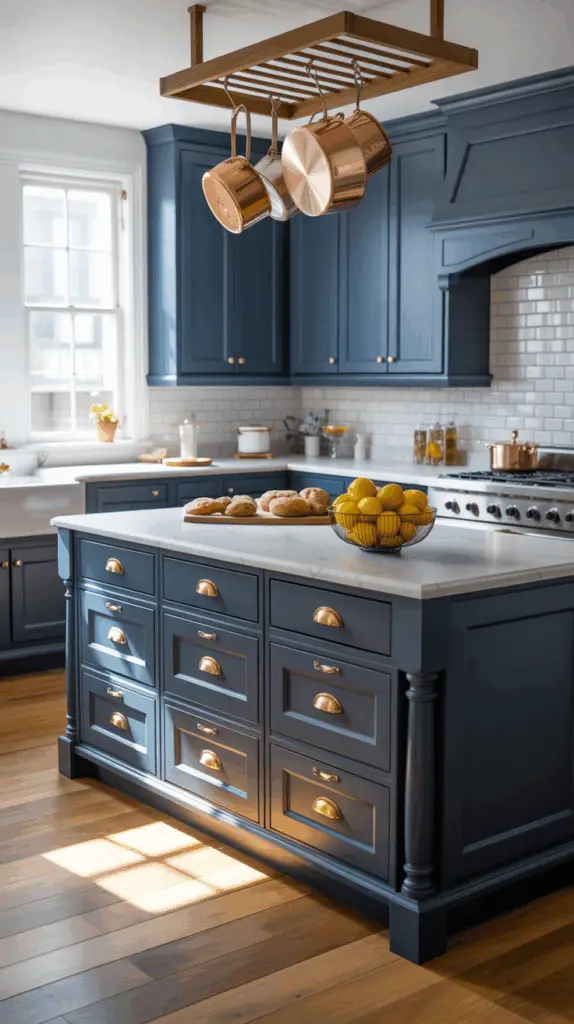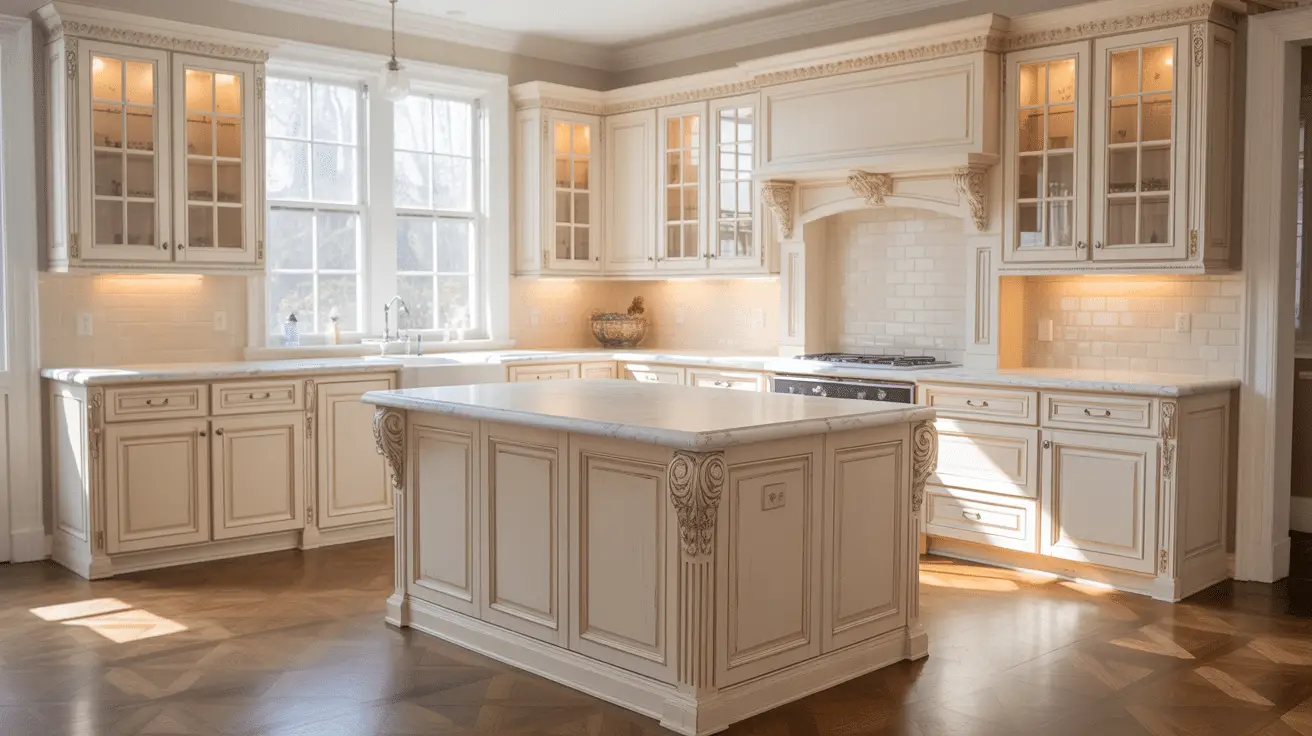Charming Traditional Kitchen Design for Everyday Living: Timeless Style Meets Function
Table of Contents
Introduction
The kitchen is often called the heart of the home, and for good reason. It’s where meals are prepared, stories are shared, and memories are made daily. While modern kitchens often grab attention with sleek lines and high-tech finishes, traditional kitchens continue to hold timeless appeal. According to recent design trends, traditional styles remain a top choice among homeowners because they balance elegance with comfort and functionality. Unlike fleeting design fads, a traditional kitchen feels warm, welcoming, and built for everyday living.
But what exactly makes a kitchen traditional? It’s more than just ornate cabinets or classic finishes—it’s about thoughtful design choices that bring a sense of charm and livability. Traditional kitchens combine craftsmanship with practicality, blending detail-rich cabinetry, timeless materials, and cozy layouts that encourage gathering.
In this article, we’ll explore the essential elements that define traditional kitchen design and how you can bring them into your home. From cabinetry and color palettes to flooring, lighting, and decor, each section will provide inspiration and practical ideas for creating a kitchen that’s as functional as it is beautiful. By the end, you’ll have a clear understanding of how to design a traditional kitchen that feels both timeless and perfectly suited for everyday living.
Defining the Traditional Kitchen Aesthetic
A traditional kitchen is rooted in classic design principles that have stood the test of time. It often features ornate details, rich textures, and an overall sense of warmth. Crown molding, raised-panel cabinetry, and natural materials like wood and stone are central to its charm. Unlike modern minimalism, traditional design embraces layered elements that feel intentional and inviting.
The layout also plays a role. Traditional kitchens prioritize balance and symmetry, with cabinetry and appliances thoughtfully placed for both visual appeal and everyday function. These kitchens are designed not only for cooking but also for gathering, often incorporating eat-in nooks or spacious islands.
Colors tend to lean toward warm neutrals, muted greens, deep blues, and classic whites. These shades provide a timeless backdrop while allowing decorative details like lighting, hardware, or tile backsplashes to shine.
Table: Traditional Kitchen Design Hallmarks
| Design Element | Traditional Feature | Effect Created |
| Cabinetry | Raised-panel, crown molding | Timeless elegance |
| Materials | Wood, stone, marble | Natural charm, authenticity |
| Colors | Warm neutrals, muted greens | Inviting, versatile |
| Layout | Balanced, symmetrical | Practical and visually pleasing |
Cabinetry and Woodwork That Define Traditional Charm
Cabinetry is often the most defining feature of a traditional kitchen. Raised-panel doors, inset cabinetry, and decorative molding distinguish this style from sleeker, modern alternatives. Woods like oak, cherry, and maple are frequently used, sometimes with stained finishes that highlight their natural grain. White or cream-painted cabinetry is also popular, providing a bright, timeless look that feels both elegant and fresh.
Glass-front cabinets are another hallmark, allowing homeowners to showcase fine dishware or decorative accents. Pairing these with closed cabinetry creates balance between display and storage. Islands often incorporate furniture-like details, such as carved legs or beadboard paneling, which enhance the handcrafted feel.
Hardware adds the finishing touch. Polished brass, brushed nickel, or oil-rubbed bronze knobs and pulls bring warmth and detail. These small elements, though understated, complete the look by connecting cabinetry to the overall design.
Table: Cabinetry Styles in Traditional Kitchens
| Cabinet Feature | Style Example | Design Impact |
| Raised-Panel Doors | Classic wood or painted finish | Adds depth and richness |
| Glass-Front Panels | Display cabinets | Visual interest, elegance |
| Crown Molding | Decorative top finish | Creates polished, timeless look |
| Furniture Details | Carved island legs, beadboard | Adds craftsmanship and charm |

Choosing Colors and Materials for Timeless Appeal
Color plays an essential role in setting the mood of a traditional kitchen. Warm, neutral bases—like cream, ivory, and soft gray—offer a versatile foundation that pairs beautifully with wood tones and natural stone. For those who want a richer aesthetic, navy blue or sage green cabinetry provides depth while maintaining timeless appeal.
Materials are equally important. Stone countertops, such as marble or granite, evoke elegance, while butcher block adds warmth and practicality. Backsplashes often feature subway tile, marble mosaics, or patterned ceramic designs that echo classic craftsmanship.
Flooring typically incorporates hardwood or stone tile, creating durability and charm underfoot. These materials not only look timeless but also withstand the wear of daily life, making them perfect for a kitchen designed for everyday living.
Table: Color and Material Combinations
| Base Color | Accent Color | Material Pairing | Mood Created |
| Soft White | Navy Blue | Marble countertops, subway tile | Fresh and classic |
| Warm Gray | Sage Green | Granite, hardwood flooring | Cozy and grounded |
| Creamy Beige | Deep Walnut Wood | Butcher block, stone flooring | Warm and inviting |
Flooring That Grounds the Traditional Kitchen
The right flooring anchors a kitchen, providing durability while enhancing its character. In traditional kitchens, hardwood flooring is a perennial favorite. Woods like oak or walnut bring warmth and continuity throughout the home, while lighter stains can create a softer, more casual feel.
Stone or tile flooring is another popular choice. Options like travertine, slate, or patterned ceramic tiles add depth and texture. These floors are not only practical but also echo the timeless character of traditional design.
For homeowners who want a blend of charm and practicality, combining wood in the main area with tile in high-traffic or cooking zones can create both functionality and visual interest. Rugs in natural fibers like wool can soften the look, adding warmth and texture underfoot.
Table: Flooring Options for Traditional Kitchens
| Flooring Type | Traditional Example | Benefit |
| Hardwood | Oak, walnut, maple | Warmth, continuity, timelessness |
| Natural Stone | Slate, travertine | Durability, texture, elegance |
| Ceramic Tile | Classic patterns, mosaics | Easy to clean, adds visual detail |
| Combination | Wood + stone/tile mix | Balances practicality and style |
Lighting That Enhances Warmth and Character
Lighting is one of the most powerful design elements in a traditional kitchen. Chandeliers or pendant lights above islands and dining areas add elegance, while sconces and under-cabinet lighting provide practicality and ambiance.
Fixtures in warm metals—such as brass, bronze, or antique nickel—pair beautifully with traditional cabinetry and hardware. Shades in glass or fabric soften the light, creating a glow that makes the kitchen feel inviting.
Layered lighting ensures the space is functional for cooking while also providing mood lighting for gatherings. Natural light is equally important: traditional kitchens often feature large windows, sometimes with mullioned designs, that flood the space with daylight and enhance its charm.
Table: Lighting Layers for Traditional Kitchens
| Lighting Type | Traditional Fixture Example | Role in Design |
| Overhead Lighting | Chandelier, pendant lights | Adds elegance, focal point |
| Task Lighting | Under-cabinet LEDs, sconces | Practical illumination for cooking |
| Accent Lighting | Decorative sconces, island lamps | Enhances ambiance and warmth |
| Natural Light | Mullioned windows | Brightens, connects with outdoors |
Traditional Decor and Accessories That Complete the Look
Accessories play a vital role in finishing a traditional kitchen. Decorative elements such as patterned rugs, pottery, or classic artwork add personality without overwhelming the space. A bowl of fresh fruit, vintage-style canisters, or copper cookware displayed on open shelving reinforces the lived-in charm.
Window treatments often include Roman shades or simple drapery in natural fabrics. These soften the overall look while maintaining elegance. Greenery—whether fresh herbs on the windowsill or potted plants on the counter—brings life and freshness.
The key is balance: accessories should enhance functionality while adding beauty. Traditional kitchens thrive on this blend of charm and practicality, making the space both usable and visually appealing.
Table: Traditional Kitchen Accessory Ideas
| Accessory Type | Example | Effect Created |
| Decorative Rugs | Persian or patterned runner | Adds warmth, ties design together |
| Pottery/Canisters | Ceramic or copper finishes | Practical, vintage-inspired charm |
| Window Treatments | Roman shades, natural drapery | Softens look, adds elegance |
| Greenery | Herbs, potted plants | Freshness, natural touch |
Conclusion
A traditional kitchen design offers more than just aesthetic beauty—it provides a sense of comfort, warmth, and timelessness that few other styles can match. From cabinetry and flooring to lighting and decor, every element works together to create a space that feels both elegant and practical. Traditional kitchens embrace craftsmanship and detail while prioritizing everyday functionality, making them ideal for families and gatherings.
By combining timeless materials, thoughtful layouts, and charming accessories, you can design a kitchen that not only meets daily needs but also becomes the true heart of the home. A charming traditional kitchen is more than a place to cook—it’s a place to live, connect, and create lasting memories.

